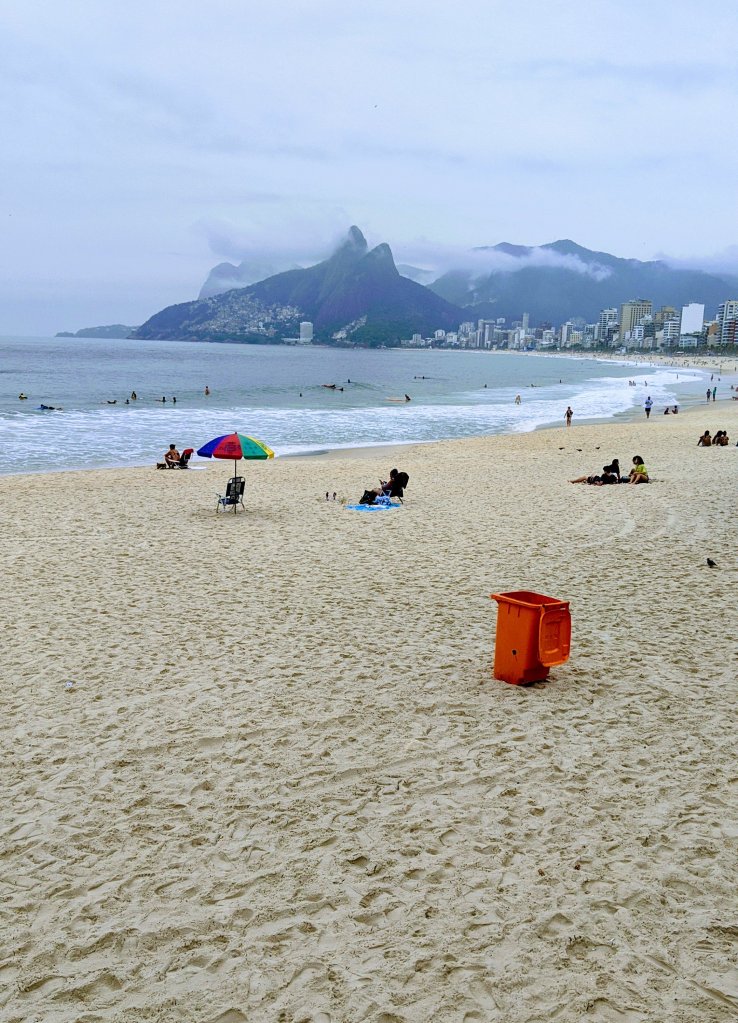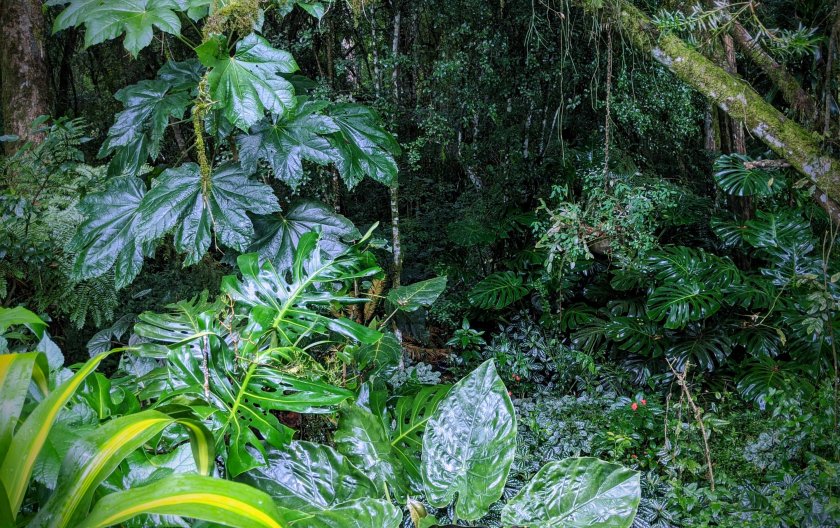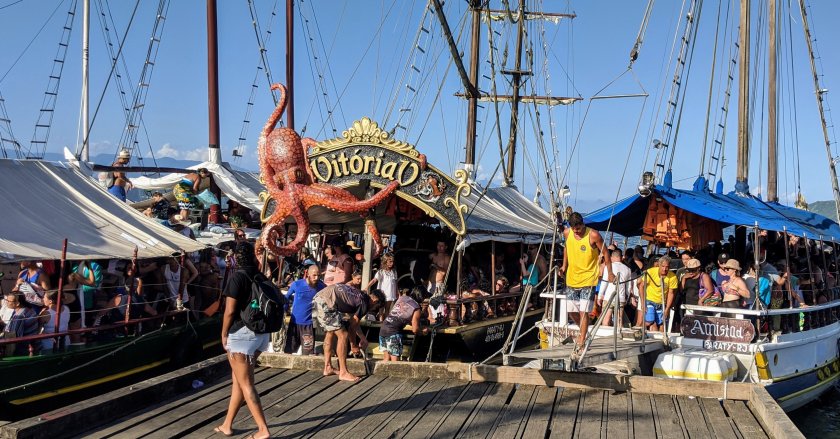When we left the coast, it started raining. Through the rain we passed the coffee fields in southern Bahia. Along the coffee fields we saw peppercorn vines and achiote bushes – of which the typical local yellow food color is extracted. It rained when we drove through a magical landscape with protruding rocks, announcing the approach of the Rio de Janeiro coast -the way it is advertised in tourist brochures. We saw so many of these odd shaped rocks, that when we arrived, Rio’s landmark had lost its magic! With the constant rain, we had no incentive to stop and arrived in Rio faster than expected. In between showers, we walked along the beaches of Ipanema and Copacabana, to visit friends we made during our travels. We camped along a lake with a shrouded view of the Corcovado and the statue of Christ the Redeemer. The lake’s edge was teeming with life: runners and bicyclists zoomed past our front door, sailboats and racing shells crossed the lake, nudging it’s wildlife to the shore, so we could admire a family of capybaras from up close. One night, the sound of complicated drum rhythms drew us out to find the source of the action. It didn’t take long before we could gaze over a low wall to witness a circle of drummers practicing for carnaval.




The clouds lifted the moment we departed Rio de Janeiro…
We were not going to wait for Carnaval; the time that the city would be flooded with tourists and criminality was high. We also didn’t feel like exploring the city in the constant rain, so after a couple of days, the travel bug pushed us on – still along the coast, towards Paraty, a town built during the Brazilian gold rush in the 17th and 18th century, now a Unesco World Heritage site. On our last trip, we had no idea of it’s existence – internet nowadays gives us so much more information than the few travel guides of forty years ago! This time around we had heard much about this small town: how pretty it is, but also very touristy…nevertheless a must see along the road to the south…

Even though we were crossing the tropic of Capricorn, and we should be in a subtropical region, the coast between Rio and Paraty was among the most lush and tropical we have seen. The road went steep up and down, following the mountainous elevations of the land. Along the road, brilliantly colored flowers popped out of a wall of green textures; large leafed climbers crept up along moist tree trunks, while occasional waterfalls added to the feeling of paradise – were it not at the street’s edge. Every now and then we spotted the turquoise ocean with a scattering of rocky islands. When we didn’t make it all the way to Paraty that day, we descended into the coastal village of Praia Grande, to spend the night alongside the fish-boat marina, where we were warmly received by some customers of a three table street side bar. Exhausted from the drive over the long and winding road, we nonetheless stayed up longer then normal, trying to keep up a conversation in Portuguese with the curious locals and, thankfully, also some English with a somewhat tipsy woman who had established herself there after her divorce and several world adventures. Before leaving the village the next morning, we explored the narrow trail that started from our camp spot…the trail led us up and over an outcrop that separated Praia Grande from the secluded beach of Prainha, where clear water gently erased our footsteps in the golden sand, and rounded granite boulders provided a private corner or an elevated spot to catch some sun rays. Of course it helped that we were there early, and left before a small crowd moved in.




We continued to Paraty, where we arrived before the shops opened, but after the tourists had shipped out to Ilha Grande for a day in the sun. For us it was a perfect opportunity to enjoy the pretty colonial facades while managing the rough, uneven (can’t even call it) cobblestone streets without twisting an ankle. By the end of the day, we went out to the dock to see loads of pirate-themed boats release thousands of passengers from a beach day on the island. Thankfully, most passengers left town, however the ones that remained were determined to have a good time. It was good we established ourselves on the far side of the parking lot, with a canal between us and the old center, so we still had a good night’s sleep.








Some weeks ago, our fridge stopped working. Fortunately we didn’t have much that needed to be refrigerated, just some butter and a large chunk of cheese- which actually tasted better in its soft and sweaty state. But it is nice to have a cool glass of water on a hot day – we missed that most of all. From our friends in Rio we’d heard that near Paraty’s marinas there would be a repair shop for our brand fridge. Thijs had already figured out what part was failing, and before the technician arrived at the shop, Thijs had found the necessary replacement part – the only one in stock. Then it was a question of minutes to have the part installed, and we were on our way, direction Curitiba to say hello to some other friends.


We were now driving through the south of Brazil. There was no comparison with the north. The roads were great, but dearly tolled. The gas stations along the highway left nothing to be desired, with a restaurant and store and sometimes a hotel, a large amount of well maintained toilets and hot showers, and ample parking space to spend the night- trucks separated from cars, campers and buses. Endless fields of soy, corn and wheat grew perfectly uniform. Immense grain collection facilities reminded us of the US’ Mid-West. We could easily navigate around the city of Curitiba, where everyone seemed to obey traffic rules. The suburbs of Curitiba were defined by gated communities and comfortable shopping malls, tennis courts and golf courses. To visit friends of our friends we went a bit beyond this cultured zone, to a yet to be developed area, which looked much more natural and relaxed. We stayed here for a while and enjoyed an incredible hospitality with new friends; we rode along in an open top Jeep to other friends inside a gated community, where we experienced the decadence of an upper crust party – all friends in a four wheel drive adventure group.


When we left, we vowed to come back after our visit to the Iguacu falls; we still wanted to revisit the southern part of Brazil. Only a few days later, in Foz de Iguaçu, we learned that this was not meant to be…our allotted stay in Brazil could not be extended. With only ten days left for Brazil, we decided to leave for Paraguay immediately, so we could use those ten days for a later visit to the Pantanal: a Brazilian wetland nature reserve which is easily accessible from Paraguay and Bolivia. So, on to Paraguay we went, looking forward to meeting another set of friends, with whom we were going to drive together for a bit. But that is an other story.






